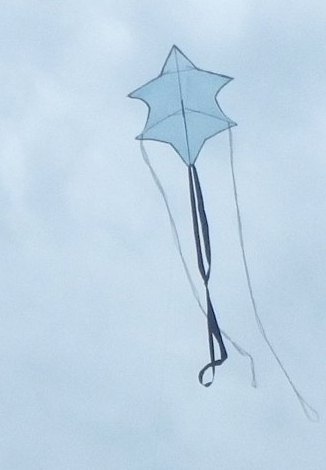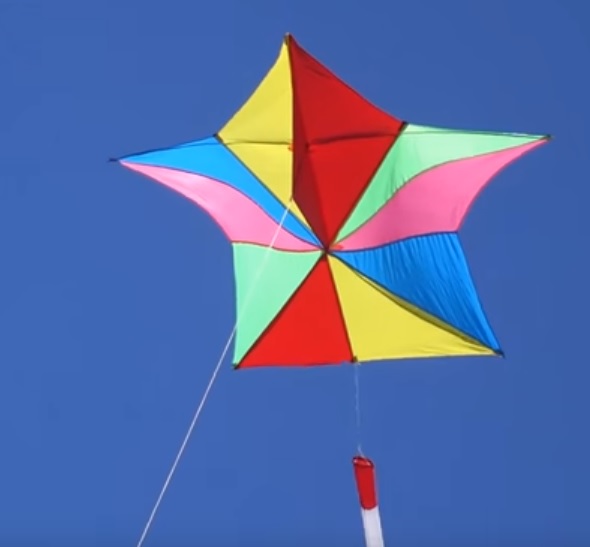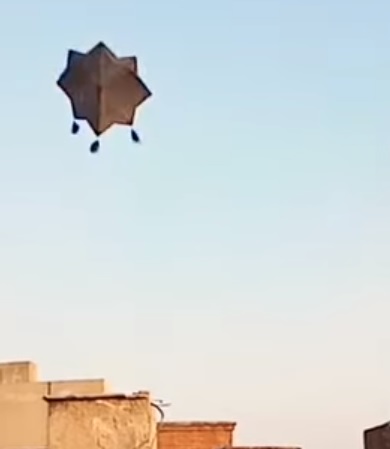Star Kite Variations
From Around the World!
A star kite is something interesting and different in comparison to the most common single-surface retail kites you might see flying down at the beach or at a festival. I was surprised to find how various cultures around the world have produced such a variety of approaches to this type of kite. It seems just about every basic aspect of the concept has been done differently! For example:
 MBK Skewer Star prototype
MBK Skewer Star prototype- The number of points on the star. This seems completely arbitrary! Perhaps some of these designers had very good reasons for this. For example, a curved horizontal spar might suit a particular arrangement of points just perfectly in the mind of the designer. My MBK Skewer Star design deliberately uses a different number from the initial examples I found, just to be different. :-)
- Point shape and distribution. Did you think they would all have identical-looking points, evenly distributed around a circle? Nope. One Indian kite-maker with a published video used some artistic license. Or perhaps he thought it might fly better. Those guys should know!
- Some designs were fighters. In other words, they are deliberately unstable until extra line tension shoots the kite off in a straight line. Some flying skill is required to steer these things! Other star-kite designs were the usual "stable with a tail" single-liners.
- Sail and spar materials. Perhaps this is not so surprising, particularly given that some designers prefer strictly traditional materials, such as paper and bamboo.
- The bridling arrangement. Most (but not all) of the designs I saw had a simple two-leg bridle. My MBK Skewer Star uses a three-leg arrangement.
Although this page focuses on single-surface kites, you might be aware of those cellular stars or star box-kites as they are also known. There's a number of retail kites of this type available.
On this site, there's more kite-making info than you can poke a stick at. :-)
Want to know the most convenient way of using it all?
The Big MBK E-book Bundle is a collection of downloads—printable PDF files which provide step-by-step instructions for many kites large and small.
Every kite in every MBK series.
Star Kites
From China
 Colorful and tough!
Colorful and tough!Leading the pack in making the star idea known among many Western kite-fliers would have to be this good-sized retail star kite from China.
The span is 175 centimeters and it's 150 centimeters from nose to tail. See the photo. As you can see, it's a typical colorful and sturdy ripstop-nylon craft. Judging by the price, the spars would have to be fiberglass rods and/or tubes—good and strong!
This kite is no fighter, having a delta-like keel and a short pair of spars near the nose with a dihedral fitting. The star does have a long curved rod going from side-tip to side-tip, like most fighters.
Apparently, this star has a great wind range, particularly with some tail added.
I've seen footage of the kite flying smoothly while a nearby
delta-conyne box is shifting nervously around in very fresh wind!
The five points make a lot of sense for a large stable single-liner. One point is like the head of a bird kite, plus one each side for wingtips plus two at the rear making a kind of fan tail. How's that for a bunch of bird-kite analogies. :-)
From Afghanistan
 Star fighter
Star fighterIf I'm wrong, correct me, someone who has seen the video. ;-) But it sure looked like the light browns of rooftops and terrain of that country.
Wow, there were no less than eight points on this one! They were all evenly spaced around, plus a tassel hung off each of the lowest three points. The tassels gave some stability but not overly much. This star kite was definitely a fighter, complete with bowed cross-spar.
Interestingly, the clip
showed the boy flying the kite right down between buildings and up into
clear air again! I must say I have very little experience flying at
negative line angles. :-) You'd have to get line in pretty quick at
times, I would imagine.
The bamboo used in construction appeared to be flat strips, in contrast to round or square rods more commonly used in kite making. The strips lent themselves to being glued in place before the tips and center were secured with sticky gold-colored patches.
Like the Indian kite, this one also made use of battens. That is, spars that are attached to the sail but not rigidly attached to other spars.
The video ended with no bridle detail (unless I just missed it), but I assume a two-leg bridle would be employed on this fighter. In fact you can see the kite flexing about the spine as the boy flier applies tension.
From India
Kite-making videos from India get large domestic audiences, I suspect. That's judging from one I saw that had a six-figure number of views and barely a word of English on the soundtrack.
The kite in this case was not your usual evenly-distributed points around a circle. Instead, the seven-pointed design had differently shaped points toward the rear. It was, however, symmetrical about the vertical axis, like the vast majority of kites everywhere.
At the risk of getting slightly off-topic, I might mention here that there do exist a few artistic types that delight in making ... asymmetric kites! By means of design and bridle adjustments, these kites can fly quite stable—with what kind of wind range, you would have to wonder. Anyway, back to stars.
I'll mention a few details now about the Indian star kite just mentioned. As is typical in southern Asia, the materials were paper and split bamboo. However, the paper was newspaper! To get rigidity into the sail, four battens were used plus a highly curved cross spar that extended far down each side of the sail. And, of course, there was a vertical spine to which was attached the common Indian two-leg bridle.
Also from India, it would appear, another video featured someone making a quite simple four-pointed star kite. The points were quite long in comparison to other stars. A little bamboo cross-piece was at the center to which were attached the four short bamboo spars. That's different. I have no doubt the kite flew adequately well, but I can't imagine it out-performing any of the other kites mentioned on this page.
A Skewer Star Kite
Of course I had to make an MBK version. :-) A rather quick-n-dirty concept kite was slapped together from bamboo skewers, plastic sheet, and clear sticking tape. After some fiddling, the kite flew successfully. You've already seen it at the top of this page.
Plenty of craft-ready bamboo skewers were sitting in bags of 100 out in the shed. You can buy these online in bulk! Otherwise, if you don't mind snipping off the points, you can buy bags of skewers from supermarkets. I find the ideal dimensions for kite making are 30 centimeters (12 inches) long x 2.5 millimeters (1/8 inch) diameter. For smaller kites, the skewers are a very handy spar material.
With a little star-kite experience under my belt, I decided to make an improved version and show you the steps.
The video below shows the last prototype of the MBK Skewer Star in action in a gusty gentle-strength breeze:
As mentioned earlier, there's more kite making on this site than you can poke a stick at. :-)
Want to know the most convenient way of using it all?
The Big MBK E-book Bundle is a collection of downloads—printable PDF files that provide step-by-step instructions for many kites large and small.
That's every kite in every MBK series.
